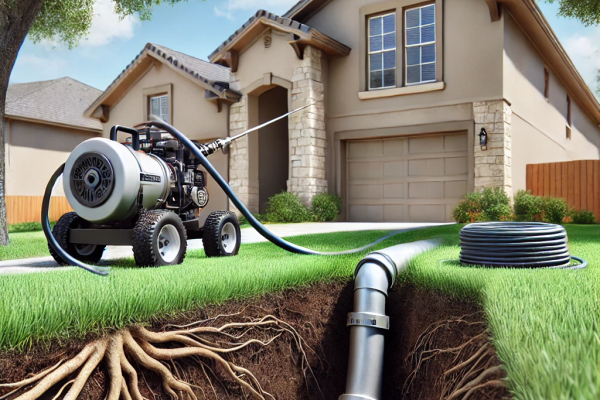
How Regular Drain Cleaning Saves You Stress and Money
Everyone—whether a homeowner, business owner, or renter—has faced the problem of clogged drains at least once. Washing dishes, washing your face, or taking a shower when the water drains too slowly can seem like a minor irritation at first glance. But what if this “minor” clog is a sign of a more serious issue? In reality, neglecting routine drain cleaning can lead to large-scale pipe damage, costly repairs, and even unsanitary conditions. After all, when the sink stops draining entirely, it’s no longer a minor inconvenience but a genuine catastrophe that can cost you a lot of money.
In this article, we’ll discuss why you shouldn’t ignore preventive drain cleaning, which methods to use and when, and why the situation in Texas deserves special attention. You’ll also learn how to save money and avoid headaches by calling in a professional plumber at the right time and following certain basic rules for your drainage system.
When a Minor Problem Turns into a Major One
We all know water should flow freely out of sinks, bathtubs, and showers without pooling or interfering with everyday hygiene routines. However, what often starts as a small annoyance can turn into a real disaster. You might think:
- “It’s just a dripping tap—I’ll fix it later.”
- “The sink drains a little slower, but that’s no big deal.”
- “The smell in the bathroom isn’t that bad; I can tolerate it.”
This type of thinking can come back to haunt you. A simple clog can build up over time, leading to unpleasant bacterial growth, pipe leaks, and other damage. Imagine making your morning coffee only to find murky water and food scraps floating in your kitchen sink—not a pleasant start to the day. Worse still, underestimating the situation can seriously affect your wallet: when a drain is completely blocked, you’ll need to make an emergency call to the plumber and might even have to replace damaged sections of piping.
Why Texans Need to Be Especially Vigilant
Texas is known not only for its storied history, cowboy spirit, and major cities like Houston, Dallas, Austin, and San Antonio, but also for its distinct climate. Summers here can be extremely hot, and in some areas, quite humid. Temperature fluctuations and periodic droughts can affect sewer and drainage systems. For instance, when temperatures soar outside, people consume more water for cooling off and personal hygiene. This puts additional strain on local sewer infrastructure, making any weak spots more vulnerable.
Moreover, in certain regions of Texas, soil can shift (sometimes because of drought), increasing the risk of pipe damage. If your drains are already “on the edge” due to accumulated clogs, changes in soil pressure can heighten the likelihood of a rupture or small cracks forming. Consequently, regular drain cleaning and pipe inspection in Texas aren’t just cautious measures but an absolute necessity to avert astronomical repair bills later on.
The Most Common Causes of Clogs
To know how best to clean your drains—and how often—you first need to understand what typically causes clogs:
Grease and Food Residue
When washing dishes—especially greasy ones—traces of oil and food gradually accumulate on the walls of your pipes, forming a dense coating. Over time, this buildup creates a “plug” that can’t easily be dissolved by conventional drain cleaners.
Hair and Pet Fur
In the bathroom and shower, hair is the leading culprit behind clogs. It binds together into a dense cluster that blocks the drain. Pet grooming in the shower or tub compounds the issue.
Hygiene Products and Miscellaneous Debris
Items like wet wipes, cotton swabs, paper towels, and more can end up in the drain by oversight and completely block the pipe.
Lime Scale and Mineral Deposits
Hard water, which is found in some parts of Texas and other regions, is rich in minerals (calcium, magnesium). These minerals settle on pipe walls over time, steadily narrowing the passage.
Tree Roots
In some cases, tree roots can invade and damage older pipes buried underground if they have cracks. As a result, you might experience slow drainage or even a total backup.
Prevention: Your Best Cost-Saving Strategy
In practice, the biggest repair bills arise when people neglect drain cleaning for years. It’s often much cheaper to invest in regular preventive measures than to pay for emergency services later on—especially when they include replacing pipes. So, what does preventive work look like?
Annual or Biennial Professional Drain Cleaning
Plumbers use specialized equipment (such as hydro-jetting systems or plumbing snakes) to clean out built-up residue from the inside of pipes. Hydro-jetting is especially efficient for stubborn grease and mineral deposits.
Controlling What Goes Down the Drain
Install strainers in your sinks and showers to catch hair and food scraps. Avoid pouring hot grease and oil down the sink. Let them cool and solidify before disposing of them in the trash.
Occasional Cleaning with Eco-Friendly Products
Enzyme-based cleaners can break down organic matter without the harsh effects of potent chemicals. They’re not as aggressive as strong chemical solutions but can serve as a good preventive measure when used regularly. Always follow the instructions on the package.
Prompt Attention to Warning Signs
If you notice the water in your sink or bathtub draining more slowly, don’t put off investigating. This might be the first sign of a growing clog. It’s better to deal with the issue early than to wait for a complete blockage.
Drain Cleaning Methods: Which One to Choose?
When it’s time to clear a clogged drain, there are several primary methods available. Your choice will depend on how severe the clog is, your budget, and the equipment at hand.
Chemical Cleaners
Many gels and powders sold in stores contain active substances designed to break down grease and organic matter. They can be a convenient solution for minor clogs but, when used repeatedly, harsh chemicals may damage pipes and harm the environment.
Plumbing Snake (Auger)
This mechanical method involves feeding a long, flexible coil into the pipe to “break through” the clog. The auger physically dislodges or extracts the obstruction, such as hair or debris. While this method is effective in most household scenarios, it requires a certain level of skill to avoid damaging pipe walls.
Hydro-Jetting
One of the most efficient solutions for serious buildups of grease and minerals. A special machine uses a powerful water jet that blasts away all the gunk. This is a safe method for pipes, very effective for tough clogs, and ideal for preventive maintenance.
Home Remedies
Some people use the classic approach: pour baking soda into the drain, add vinegar, wait 15–30 minutes, then rinse with hot water. While this can work for minor issues, it’s generally only a temporary fix and may not be sufficient for serious clogs.
Real-Life Stories: Lessons Learned the Hard Way
To grasp how critical it is to clean your drains regularly, just look at a few cautionary tales from people who waited too long to call a plumber.
Story #1: Bad Luck at a Small Café
The owner of a café in a Dallas suburb noticed an unpleasant odor in the kitchen and assumed it was due to improperly washed dishes. The smell not only lingered but intensified. It turned out that grease buildup in the pipes had reached a tipping point, causing wastewater to leak into the basement. Beyond a plumber’s services, the owner had to pay extra to get rid of mold.
Story #2: An Apartment in a High-Rise
A young couple in Houston lived on the first floor of an older building. Neighbors above them were regularly flushing items—wipes, hygiene products—that shouldn’t go down the toilet at all. Eventually, the pipes were overwhelmed, and the blockage caused water to flood their bathroom. The resulting emergency repairs and disinfection were expensive and stressful.
Story #3: A Sweltering Summer in Austin
One family noticed their shower drain was sluggish. Instead of calling a plumber, they tried vinegar and baking soda. By late summer, the problem had become critical: the drain was entirely blocked—not just in the shower, but in the bathroom sink as well. A plumbing crew that arrived found grease and mineral buildup throughout the pipe, along with small roots that had entered through a tiny crack. The repair bill wasn’t cheap.
All of these headaches could have been prevented with timely preventive drain cleaning.
The Role of a Professional Plumber
DIY drain cleaning might work for minor clogs, but if the problem is widespread, it’s wise to call a professional. Why?
- Professionals have specialized equipment. Hydro-jetting machines, various auger attachments, and camera diagnostics let plumbers quickly pinpoint and characterize the clog, then clear it with minimal risk of pipe damage.
- Saves you time and effort. It’s not worth your while to spend hours wrestling with the pipes if a professional can fix the issue in 30 to 60 minutes. Also, a botched cleaning attempt may damage your plumbing system, costing even more in the long run.
- Warranty and safety. When you hire a licensed plumbing company, you get certain guarantees on their work. On top of that, a professional will provide tips on keeping your drains in good shape.
When and How Often to Clean Drains
For a typical household of four people, it’s advisable to have your drains cleaned professionally once a year or every two years. However, individual circumstances vary. If you have a big family, cook frequently, and your local water is quite hard, you might need more frequent preventive measures. If you live alone, rarely use the kitchen, and keep an eye on your drains—employing the occasional cleaning product—you might only need service every two to three years.
In Texas, where hot weather can boost water usage and shifting soil can threaten plumbing lines, it’s best not to postpone a plumber’s visit. Pay special attention if you notice slow drainage or odd sounds in your pipes—these are the “early warning signs” of a bigger problem.
Environmental Considerations
People often underestimate how “drain problems” affect the environment. If a clog causes a pipe to burst, it can pollute the soil and groundwater. Large amounts of chemical cleaners can also harm the environment. That’s why many professionals increasingly recommend mechanical and hydro-jetting methods, which are not only highly effective but also safer for nature.
Conclusion: Be Proactive
Regular drain cleaning isn’t a waste of time or money; it’s one of the most reliable ways to ward off a host of problems. From foul odors and unsanitary conditions to extensive repairs—these issues can all be prevented by caring for your pipes in advance. This is especially true in Texas, where climate factors and higher demands on water-and-sewer systems can amplify risks.
If you don’t want to watch water back up in your sink again—if you don’t want to be frantically searching for an overnight plumber—be sure to maintain your drains. Use strainers, go for milder cleaning solutions, and call in the professionals at least once a year. With these measures, your water will keep flowing smoothly, and your life will be free of one more troublesome headache.
Don’t let a clog catch you off guard—take charge now, and your plumbing system will serve you well for many years, without major breakdowns or unnecessary expenses!






